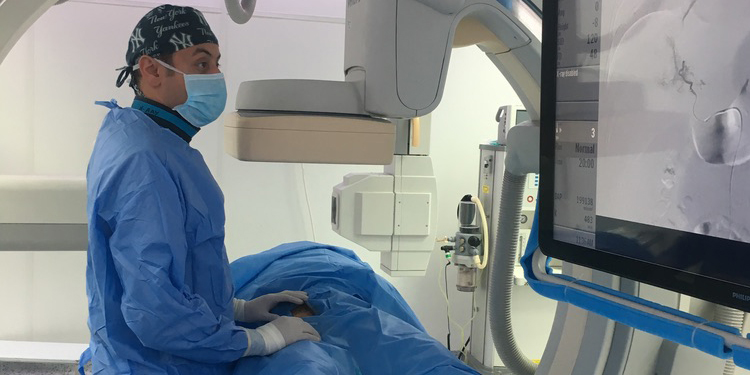
Percutaneous Endoscopic Gastrostomy (PEG): Overview
Interventional Radiology: Transforming Patient Care
Interventional radiology (IR) has transformed the medical field with its innovative, minimally invasive techniques. Using imaging technologies such as X-rays, CT scans, MRI, and ultrasound, interventional radiologists diagnose and treat various conditions without the need for major surgery. These cutting-edge procedures provide patients with faster recovery times, reduced risks, and highly targeted treatments.
In this article, we explore the top five procedures performed by interventional radiologists and how they are revolutionizing patient care.
1. Angioplasty and Stenting
Overview:
Angioplasty and stenting are among the most commonly performed procedures in interventional radiology. These techniques are used to treat narrowed or blocked blood vessels, typically caused by atherosclerosis. The procedure involves threading a catheter with a small balloon at its tip into the affected artery. The balloon is inflated to widen the vessel, and in many cases, a stent—a tiny mesh tube—is placed to keep the artery open.
Impact on Patient Care:
- Minimally Invasive: Unlike traditional bypass surgery, angioplasty and stenting require only a small incision, reducing recovery time and the risk of complications.
- Life-Saving: These procedures are critical for treating acute conditions such as heart attacks and peripheral artery disease.
- Improved Quality of Life: Patients often experience immediate relief from symptoms like chest pain and shortness of breath.
Case Example:
A patient with critical limb ischemia due to peripheral artery disease can avoid amputation by undergoing angioplasty, restoring blood flow and preserving the limb.
2. Embolization
Overview:
Embolization involves blocking blood flow to specific areas of the body to treat conditions such as tumors, uterine fibroids, or abnormal blood vessel formations. The procedure is performed by injecting tiny particles or coils into the targeted blood vessels.
Types of Embolization:
- Uterine Fibroid Embolization (UFE): Used to shrink fibroids and relieve symptoms like heavy menstrual bleeding and pelvic pain.
- Prostatic Artery Embolization (PAE): Used to shrink the size of the prostate and relieve symptoms like frequency and urgency of urination.
- Tumor Embolization: Cuts off blood supply to tumors, often in preparation for surgical removal or to enhance the efficacy of chemotherapy.
- Bleeding Control: Stops life-threatening internal bleeding due to trauma or gastrointestinal issues.
Impact on Patient Care:
- Organ Preservation: Embolization often eliminates the need for surgical removal of affected organs, such as the uterus in fibroid cases.
- Targeted Treatment: Minimizes damage to healthy tissues while effectively treating the affected area.
- Quick Recovery: Most patients return to normal activities within days.
Case Example:
A woman with symptomatic fibroids undergoes uterine fibroid embolization and avoids a hysterectomy, retaining her fertility and experiencing significant symptom relief.
3. Radiofrequency Ablation (RFA)
Overview:
These image-guided techniques are used to treat tumors and abnormal tissues by destroying them with heat (RFA). A needle-like probe is inserted into the tumor, and energy is delivered to destroy cancerous or problematic cells.
Common Applications:
- Liver Tumors: Both primary and metastatic cancers.
- Kidney and Lung Tumors: When surgery is not an option.
- Bone Pain Relief: Treats painful metastatic bone lesions.
Impact on Patient Care:
- Minimally Invasive Cancer Treatment: Provides an alternative for patients who are not candidates for surgery.
- Outpatient Procedure: Many cases require only local anesthesia, allowing patients to return home the same day.
- Reduced Pain: Particularly beneficial for managing bone pain caused by metastases.
Case Example:
A patient with inoperable liver cancer undergoes RFA, achieving significant tumor reduction and prolonged survival with minimal side effects.
4. Needle Biopsy and Fluid Drainage
Overview:
Needle biopsy and fluid drainage are cornerstone procedures in interventional radiology. Using imaging guidance, interventional radiologists insert a thin needle to obtain tissue samples or drain excess fluid from the body.
Applications:
- Biopsy: Diagnosing cancers, infections, and inflammatory conditions.
- Fluid Drainage: Removing abscesses, cysts, or pleural effusions to alleviate discomfort and prevent complications.
Impact on Patient Care:
- High Precision: Imaging ensures accurate targeting, reducing the need for repeat procedures.
- Minimal Discomfort: The procedure is quick and typically performed under local anesthesia.
- Critical Diagnosis: Enables prompt and accurate identification of diseases, leading to early treatment.
Case Example:
A patient with suspected lung cancer undergoes a needle biopsy, confirming the diagnosis and enabling timely initiation of targeted therapy.
5. Thrombectomy and Thrombolysis
Overview:
Thrombectomy and thrombolysis are life-saving procedures used to remove or dissolve blood clots in conditions such as deep vein thrombosis (DVT), pulmonary embolism, or stroke. Thrombectomy involves physically removing the clot, while thrombolysis uses clot-dissolving medications delivered directly to the site.
Impact on Patient Care:
- Rapid Symptom Relief: Immediate restoration of blood flow prevents long-term damage.
- Stroke Treatment: In ischemic strokes, these procedures can save lives and improve functional outcomes.
- Prevention of Complications: Reduces the risk of post-thrombotic syndrome or recurrent clots.
Case Example:
A patient experiencing a massive pulmonary embolism undergoes catheter-directed thrombolysis, regaining normal breathing and avoiding further complications.
The Revolution of Interventional Radiology
The procedures highlighted above illustrate the transformative impact of interventional radiology on patient care. By providing safer, faster, and more precise alternatives to traditional surgery, IR is reshaping the medical landscape. Patients benefit from less invasive treatments with shorter hospital stays and quicker recoveries, while healthcare systems see reduced costs and improved outcomes.
Conclusion
Interventional radiology continues to push the boundaries of what is possible in modern medicine. Procedures like angioplasty, embolization, ablation, biopsy, and thrombectomy showcase the versatility and efficacy of this specialty. Whether treating life-threatening conditions or improving quality of life, interventional radiologists are at the forefront of delivering innovative, patient-centered care. As technology and techniques evolve, the role of interventional radiology will only grow, offering hope and healing to millions around the world.

